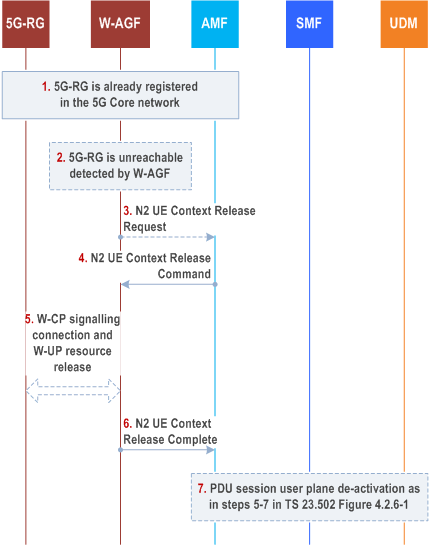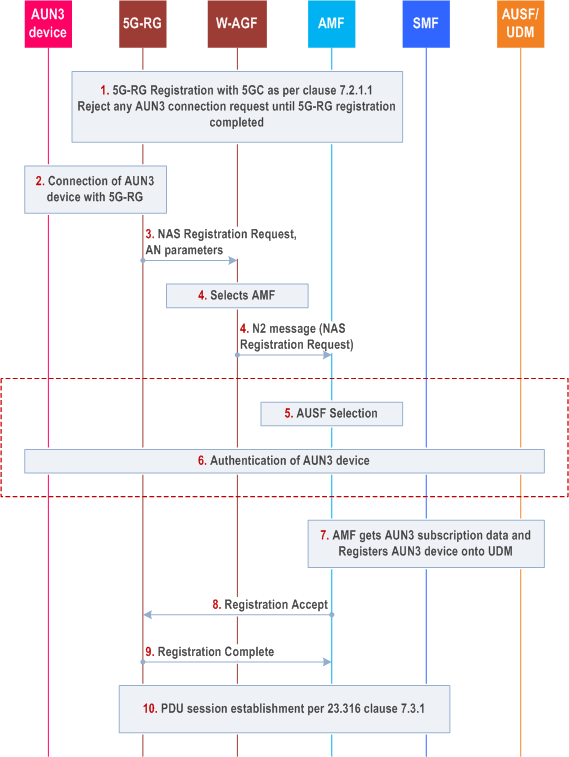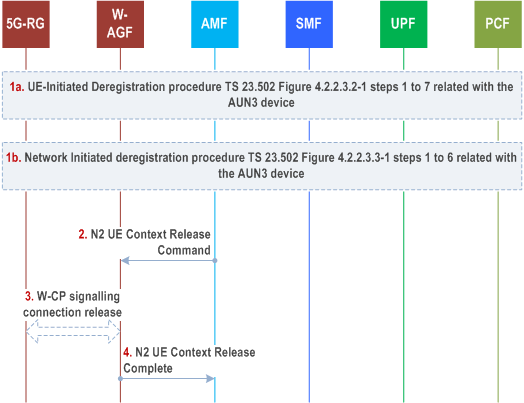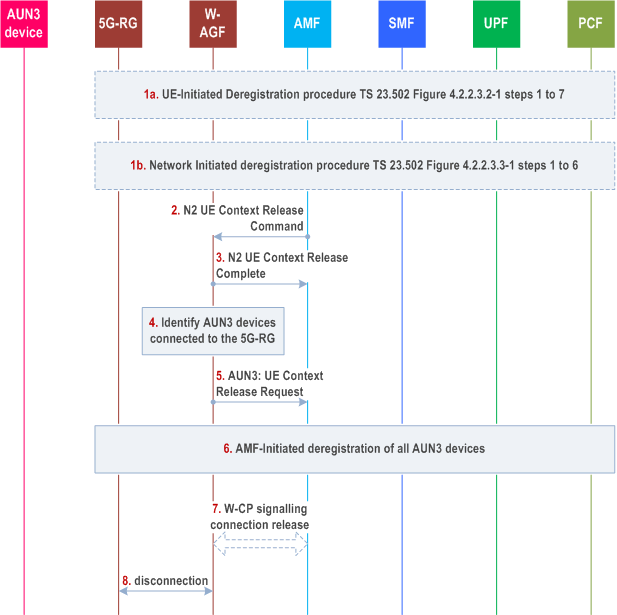Content for TS 23.316 Word version: 19.0.0
1…
4…
4.5…
4.7…
4.10…
4.10b…
4.11…
5…
6…
7…
7.2.2…
7.2.3…
7.2.4…
7.3…
7.6…
7.7…
8…
9…
9.5…
10…
A…
C…
7.2.4 Reachability procedures
7.2.5 AN Release
7.2.5.1 General
7.2.5.2 5G-RG AN Release via W-5GAN
7.2.5.3 FN-RG AN Release via W-5GAN
7.2.6 N2 procedures
7.2.6.0 General
7.2.6.1 N2 procedures via W-5GAN Access
7.2.7 5G-RG and FN-RG Capability Match Request procedure
7.2.8 Connection, Registration and Mobility Management procedures for AUN3 devices
7.2.8.1 AUN3 device Registration via W-5GAN
7.2.8.2 AUN3 device De-registration via W-5GAN
7.2.8.3 5G-RG Deregistration via W-5GAN when it is also serving AUN3 devices
7.2.8.4 N2 release related with a 5G-RG also serving AUN3 devices
...
...
7.2.4 Reachability procedures p. 53
The procedures described in clause 4.2.5 of TS 23.502 are not applicable for 5G-RG and FN-RG access via W-5GAN.
7.2.5 AN Release p. 53
7.2.5.1 General p. 53
The AN Release procedure via W-5GAN access is used by the W-5GAN or the AMF to release the logical NG-AP signalling connection and the associated N3 User Plane connections between the W-5GAN and the 5GC.
7.2.5.2 5G-RG AN Release via W-5GAN p. 53
The procedure will move the 5G-RG from CM-CONNECTED to CM-IDLE in AMF, and all 5G-RG related context information is deleted in the W-AGF.
Both W-AGF initiated and AMF-initiated AN release in the W-5GAN procedures are shown in Figure 7.2.5.2-1.

Step 1.
The 5G-RG has already registered in the 5GC and may have established one or multiple PDU Sessions.
Step 2.
The W-AGF detects that the 5G-RG is not reachable.
Step 3.
The W-AGF sends a N2 UE Context Release Request message to the AMF This step is equivalent to step 1b of Figure 4.2.6-1 in TS 23.502.
Step 4.
AMF to W-AGF: If the AMF receives the N2 UE Context Release Request from W-AGF or if due to an internal AMF event the AMF wants to release N2 signalling, the AMF sends an N2 UE Context Release Command (Cause) to the W-AGF. The cause indicated is cause from step 3 or a cause due to internal AMF event. This step is equivalent to step 2 in Figure 4.2.6-1 of TS 23.502.
Step 5.
If the W-CP signalling connection and W-UP resources has not been released yet, the W-AGF releases the W-CP connection and W-UP resources with a procedure out of scope of 3GPP. The W-AGF sends to the 5G-RG the indication of the release reason if received in step 4.
Step 6.
W-AGF to AMF: The W-AGF confirms the release of the 5G-RG-associated N2-logical connection by returning N2 UE Context Release Complete (list of PDU Session ID(s) with active N3 user plane) to the AMF as in step 4 defined in clause 4.2.6 of TS 23.502. The AMF marks the 5G-RG as CM-IDLE state in non-3GPP access.
Step 7.
For each of the PDU Sessions in the N2 UE Context Release Complete, the steps 5 to 7 in clause 4.2.6 of TS 23.502 are performed (PDU Session Update SM Context). After the AMF receives the Nsmf_PDUSession_UpdateSMContext Response as in step 7 in clause 4.2.6 of TS 23.502, the AMF considers the N3 connection as released. If list of PDU Session ID(s) with active N3 user plane is included in step 3, then this step is performed before step 4.
7.2.5.3 FN-RG AN Release via W-5GAN p. 55
The AN release procedure for the FN-RG is similar to that of 5G-RG described in clause 7.2.5.2 but with the following differences:
- The 5G-RG is replaced with a FN-RG.
- In step 5, the W-AGF may initiate the release of the L-W-CP signalling and L-W-UP resources between the FN-RG and W-AGF based on legacy protocols.
7.2.6 N2 procedures p. 55
7.2.6.0 General p. 55
This clause specifies delta for N2 procedures defined in clause 4.2.7 of TS 23.502 for 5G-RG and FN-RG.
7.2.6.1 N2 procedures via W-5GAN Access p. 55
At power up, restart and when modifications are applied, the W-AGF node and AMF use non-UE related N2 signalling to exchange configuration data. The N2 Configuration as described in clause 4.2.7.1 of TS 23.502 is used with the following differences:
- The 5G-AN corresponds to the W-AGF.
- The 5G-AN corresponds to the W-AGF.
- The UE corresponds to 5G-RG.
- The 5G-AN corresponds to the W-AGF.
- The UE corresponds to W-AGF on behalf of FN-RG.
-
If the W-AGF does not have any UE identities (i.e. a GUAMI or a 5G-S-TMSI) for the FN-RG, e.g. during Initial Registration procedure, the following differences are further applied:
- In step 2, the W-AGF shall handle the access specific messages received from the FN-RG as described in BBF TR-456 [9] and WT-457 [10], e.g. PPPoE messages, and does not forward them to the AMF via the selected TNL association. Instead, the W-AGF shall send NAS messages on behalf of the FN-RG to the AMF via the selected TNL association.
- Step 3 can only take place during the Initial Registration procedure.
- The AMF may decide to modify the NGAP UE-TNLA-binding toward other 5G-AN nodes such as W-AGF. This is done if AMF is changed and old AMF have existing NGAP UE-TNLA-bindings toward another W-AGF.
- The 5G-AN corresponds to the W-AGF.
- The UE corresponds to 5G-RG.
- The 5G-AN corresponds to the W-AGF.
- The UE corresponds to W-AGF on behalf of FN-RG.
7.2.7 5G-RG and FN-RG Capability Match Request procedure p. 56
This procedure is not applicable to 5G-RG and FN-RG access via wireline access.
7.2.8 Connection, Registration and Mobility Management procedures for AUN3 devices |R18| p. 56
7.2.8.1 AUN3 device Registration via W-5GAN p. 56
An authenticable non-3GPP devices (AUN3) may get connected behind 5G-RG as defined in clause 4.10c.
This clause specifies how an AUN3 device can be registered via 5G-RG.

Step 1.
The 5G-RG registers to 5GC as specified in clause 7.2.1.1:
Any AUN3 device connection request prior to step 1 shall be rejected by the 5G-RG.
Step 2.
The AUN3 device connects to the 5G-RG via non-3GPP access network (e.g., WLAN). An authentication procedure is triggered. This can be done either by AUN3 device sending a EAPOL-start frame to the 5G-RG or 5G-RG receives a frame from an unknown MAC address. The 5G-RG receives a permanent identifier from the AUN3 device (e.g. an NAI in form of username@realm). If the realm part is different from the realm associated with the PLMN that the 5G-RG belongs to, the 5G-RG stops performing following procedure and reject the AUN3 device.
Step 3.
This shall be same as step 3 of Figure 7.2.1.1-1 with the following addition:
Step 4.
- W-CP AN parameters may contain an indicator that the W-CP connection is for an AUN3 device;
- The 5G-RG always provides a SUCI as AUN3 device identity information in the registration request and constructs the SUCI from the NAI received within EAP-Identity issued by the AUN3 device as defined in TS 33.501;
- The 5G-RG uses default values, which are the same for all AUN3 devices it serves, to populate the parameters in the Registration Request message built on behalf of an AUN3 device. For example, the 5G-RG issues the Registration Request with no S-NSSAI; and
- When W-AGF provides (over N2) ULI to be associated with an AUN3 device, if the AUN3 device is connected behind a 5G-BRG, the W-AGF builds the AUN3's ULI using the ULI of the 5G-BRG connecting the AUN3 device. If AUN3 device is connected behind the 5G-CRG, the W-AGF builds the ULI using the GCI and HFC node ID of the 5G-CRG connecting the AUN3 device.
The W-AGF selects an AMF based on the received AN parameter provided by the 5G-RG and based on local policy, as specified in clause 6.3.5 of TS 23.501. The W-AGF shall determine that a W-CP connection is for an AUN3 device and apply corresponding policies.
The W-AGF sends an NGAP INITIAL UE message to the selected AMF. For an AUN3 device, the W-AGF indicates to AMF if the N2 connection relates to an AUN3 device and if there is an existing N2 connection for a 5G-RG connected to the same GLI/GCI (where the initial NAS message related with NGAP INITIAL UE message has been received).
If the W-AGF indicated for an AUN3 device that there is no existing 5G-RG N2 connection for a 5G-RG connected to the same GLI/GCI, then the AMF rejects the registration request and further steps of this procedure are skipped. Otherwise, the procedure continues.
Step 5.
AMF selects AUSF as specified in clause 6.3.4 of TS 23.501.
Step 6.
The AUSF executes the authentication of the AUN3 device following TS 33.501. The AUSF selects the UDM as described in clause 6.3.8 of TS 23.501 and gets the authentication data of the AUN3 device, from UDM. EAP based authentication defined in TS 33.501 is performed between the AUSF and the AUN3 device. Once the AUN3 device has been authenticated, the AUSF provides relevant security related information to the AMF. AUSF shall return the SUPI corresponding to the AUN3 device to AMF only after the authentication is successful.
Step 7.
Same as steps 7 to 12 of Figure 7.2.1.1-1 with following modifications:
Step 8.
- If step 7 of Figure 7.2.1.1-1 is a NAS Security Mode Command, it uses NULL encryption and NULL integrity protection as described in TS 33.501;
- The 5G RG uses the MAC address of the AUN3 device as a PEI.
- The AMF shall reject the registration request if the W-AGF indicates to AMF in step 4 that the N2 connection relates to an AUN3 device and the parameter "AUN3 device connectivity allowed" in the Access and Mobility Subscription Data is not present or it indicates that the device is not allowed to connect as an AUN3 device.
The AMF sends the Registration Accept message related to the AUN3 device to the 5G-RG. This step is executed over the NAS signalling connection and the N2 connection related to the AUN3 device.
Step 9.
The 5G-RG sends the Registration Complete message related to the AUN3 device to the AMF, when the procedure is completed. This step is executed over NAS signalling connection and N2 connection related to the AUN3 device. The 5G-RG shall store the 5G-GUTI of AUN3 device to be able to use it potential later NAS procedures related with the AUN3 device.
Step 10.
The 5G-RG receives the URSP corresponding to the AUN3 device and continues by requesting the establishment of a PDU Session on behalf of the AUN3 device as specified in clause 7.3.1.
7.2.8.2 AUN3 device De-registration via W-5GAN p. 58
AUN3 device may get connected behind 5G-RG as defined in clause 4.10c. This clause specifies how an AUN3 device can be de-registered via 5G-RG.

Step 1a.
The AUN3 device triggers a disconnection request to the 5G-RG.
The 5G-RG sends a De-registration request on behalf of the AUN3 device. This triggers step 1a of Figure 7.2.1.2-1 with the deregistration targeting the AUN3 device and not the 5G-RG. This step is executed over the AUN3 device's NAS signalling connection and AUN3 device's N2 connection.
Step 1b.
The network (AMF or UDM) may determine to de-register an AUN3. This triggers step 1b of Figure 7.2.1.2-1 with the deregistration targeting the AUN3 device and not the 5G-RG.
Step 2.
AMF to W-AGF: The AMF sends a N2 UE Context Release Command message to the W-AGF as defined in step 2 of Figure 7.2.1.2-1 but for the N2 connection related with the AUN3 device. W-AGF removes W-CP AN context information for the AUN3 device.
Step 3.
As defined in step 3 of Figure 7.2.1.2-1 but for the signalling connection related with the AUN3 device.
Step 4.
The W-AGF sends a N2 UE Context Release Complete message to the AMF.
7.2.8.3 5G-RG Deregistration via W-5GAN when it is also serving AUN3 devices p. 60

Step 1-3.
The same as steps 1-3 for Figure 7.2.1-1 with the following modification:
In the case of 5G-RG initiated deregistration, 5G-RG shall first deregister each of the registered AUN3 devices connected to it (if any) before initiating the deregistration of itself.
Step 4.
W-AGF controls if there exist any AUN3 devices connected to the 5G-RG that are registered to the 5GC through the W-AGF. If there are no AUN3 devices, then steps 5 and 6 shall be ignored.
Step 5.
[conditional] For each AUN3 device identified in step 4, the W-AGF shall send AN Release request as specified in clause 4.2.6 of TS 23.502. Here, the cause should indicate the disconnection of 5G-RG.
Step 6.
[conditional] For each AUN3 device, upon receiving the AN Release request with the cause specified in step 5, the AMF shall deregister the AUN3 device as specified in clause 4.2.2.3.3 of TS 23.502, without sending a Deregistration Request message to the 5G-RG. This deregistration involves only the 5GC and the release of the signalling connection with the W-AGF.
Step 7.
The W-AGF may initiate the release of the signalling connection between 5G-RG and W-AGF.
Step 8.
The 5G-RG disconnects the AUN3 device. How this is done is outside of 3GPP scope.
7.2.8.4 N2 release related with a 5G-RG also serving AUN3 devices p. 61
When a W-AGF receives a N2 UE Context Release Command for a N2 connection related with a 5G -RG, the W-AGF identifies if there exist any AUN3 device connected to the 5G-RG through the W-AGF. For each identified AUN3 device, the W-AGF invokes step 5 and 6 of Figure 7.2.8.3-1.